The CompNet Competitiveness Database
The Competitiveness Research Network (CompNet) is a forum for high level research and policy analysis in the areas of competitiveness and productivity. Founded in 2012 by the European System of Central Banks (ESCB) to foster the debate on competitiveness issues among partner institutions and researchers, it aims at providing a robust theoretical and empirical link between drivers of competitiveness and macroeconomic performance for research and policy analysis purposes. For further information and details, please visit the CompNet website.
Data and Methods
CompNet has created a competitiveness indicator dataset including a number of European countries. The database is unique in terms of its coverage and cross-dimensional analysis potential as it links, for example, trade or the financial status of firms with their productivity.
For a description of the database and methodological issues please refer to the documentation provided on the Data Section of the CompNet webpage.
DOI: 10.18717/CompNet9
DOI: 10.18717/CompNet8
DOI: 10.18717/CompNet7
DOI: 10.18717/CompNet6
Data Access
All researchers can apply to have access to the CompNet competitiveness data by submitting the data request form to the CompNet team. CompNet members and participating institutions that would like to access the data are requested to submit a shortened project description that is available upon request.
Publications
CompNet members have published more than 50 papers both in the ECB’s Working Paper Series and in a number of peer-reviewed journals. The detailed list of publications is reported on the Research Ouput Section of the CompNet webpage.
Furthermore, in 2017, CompNet has set up its own series of discussion papers:
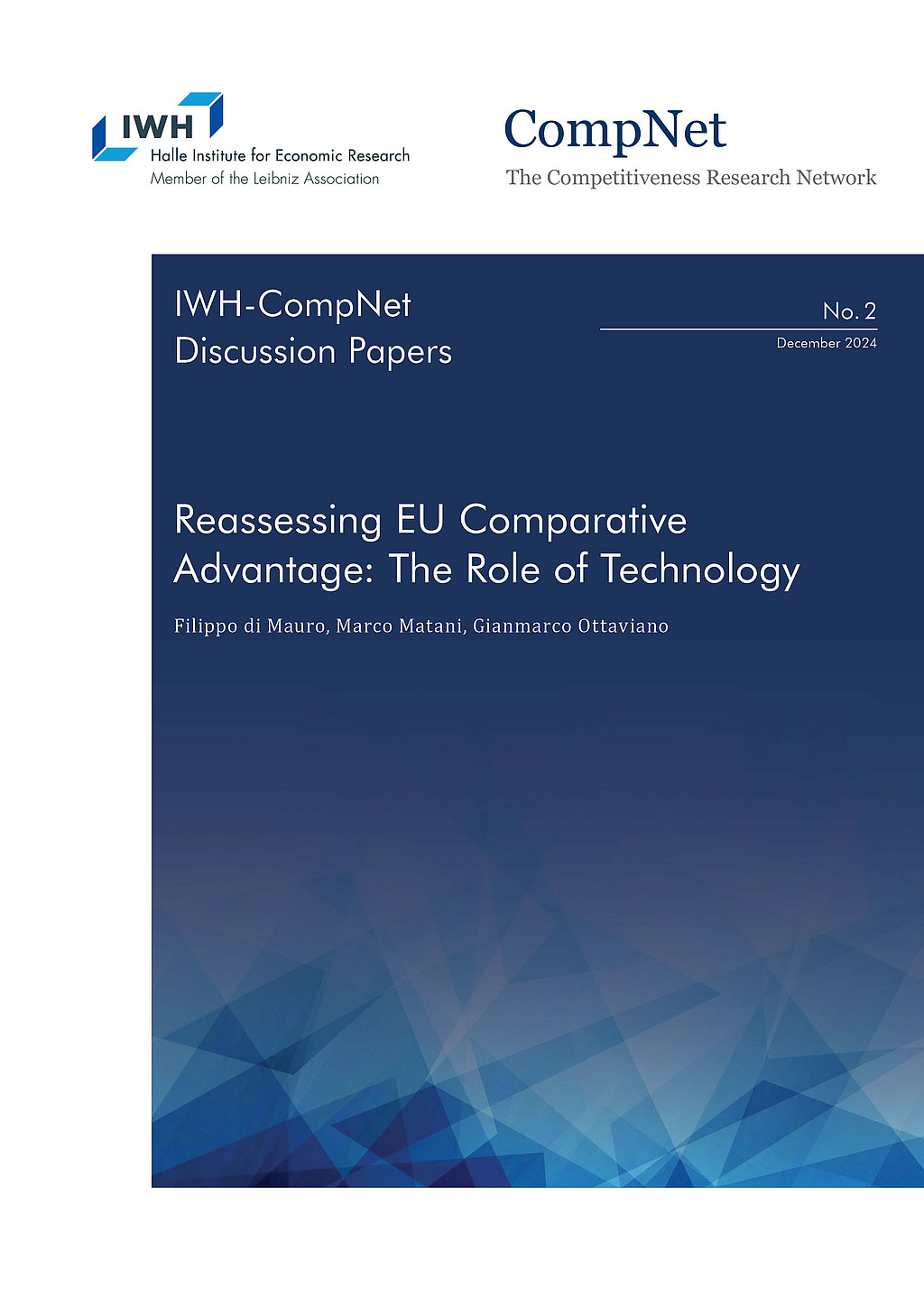
Reassessing EU Comparative Advantage: The Role of Technology
in: IWH-CompNet Discussion Papers, Nr. 2, 2024
Abstract
<p>Based on the sufficient statistics approach developed by Huang and Ottaviano (2024), we show how the state of technology of European industries relative to the rest of the world can be empirically assessed in a way that is simple in terms of computation, parsimonious in terms of data requirements, but still comprehensive in terms of information. The lack of systematic cross-industry correlation between export specialization and technological advantage suggests that standard measures of revealed comparative advantage only imperfectly capture a country’s technological prowess due to the concurrent influences of factor prices, market size, markups, firm selection and market share reallocation.</p>
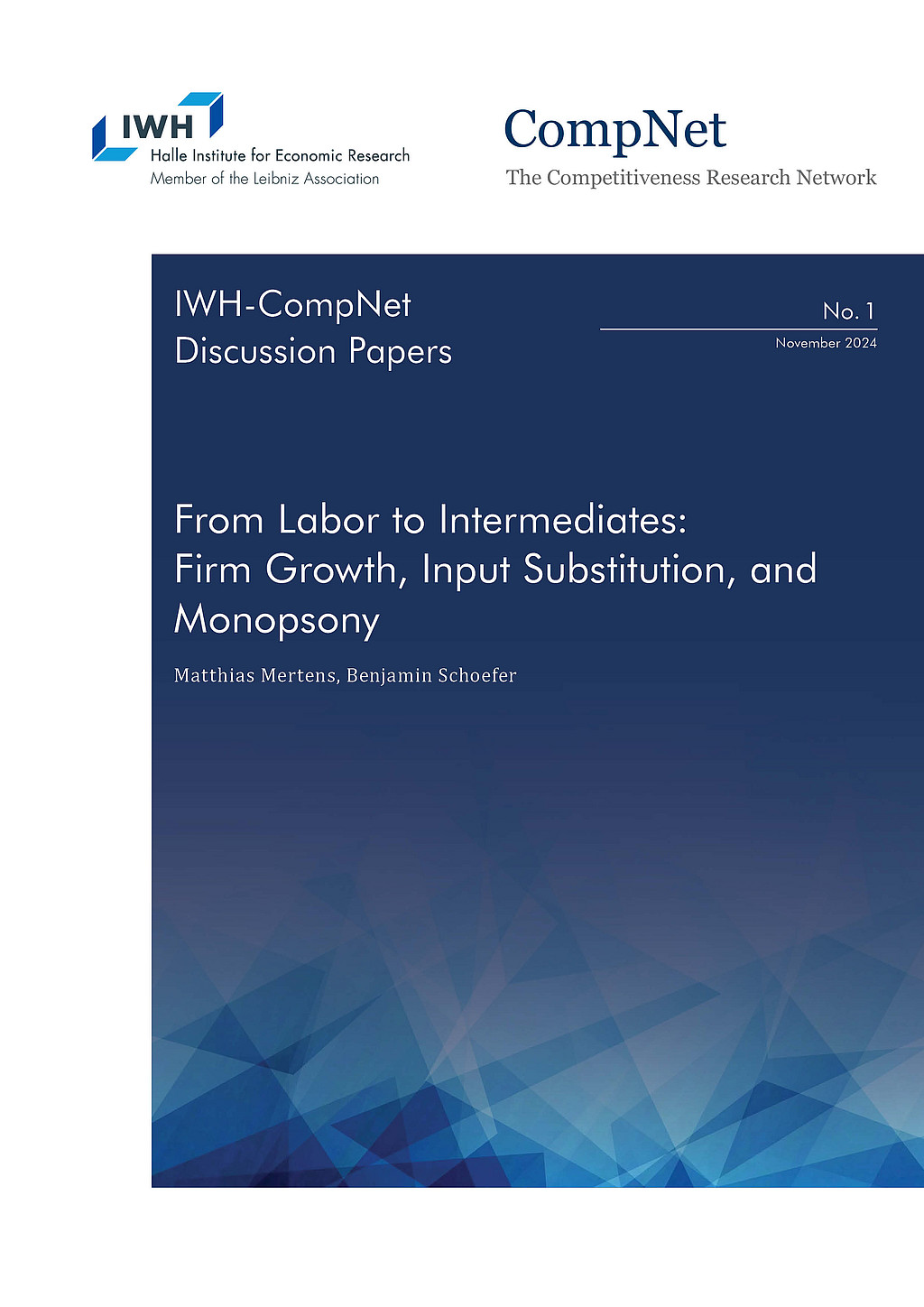
From Labor to Intermediates: Firm Growth, Input Substitution, and Monopsony
in: IWH-CompNet Discussion Papers, Nr. 1, 2024
Abstract
<p>We document and dissect a new stylized fact about firm growth: the shift from labor to intermediate inputs. This shift occurs in input quantities, cost and output shares, and output elasticities. We establish this fact using German firm-level data and replicate it in administrative firm data from 11 additional countries. We also document these patterns in micro-aggregated industry data for 20 European countries (and, with respect to industry cost shares, for the US). We rationalize this novel regularity within a parsimonious model featuring (i) an elasticity of substitution between intermediates and labor that exceeds unity, and (ii) an increasing shadow price of labor relative to intermediates, due to monopsony power over labor or labor adjustment costs. The shift from labor to intermediates accounts for one half to one third of the decline in the labor share in growing firms (the remainder is due to wage markdowns and markups) and rationalizes most of the labor share decline in growing industries.</p>
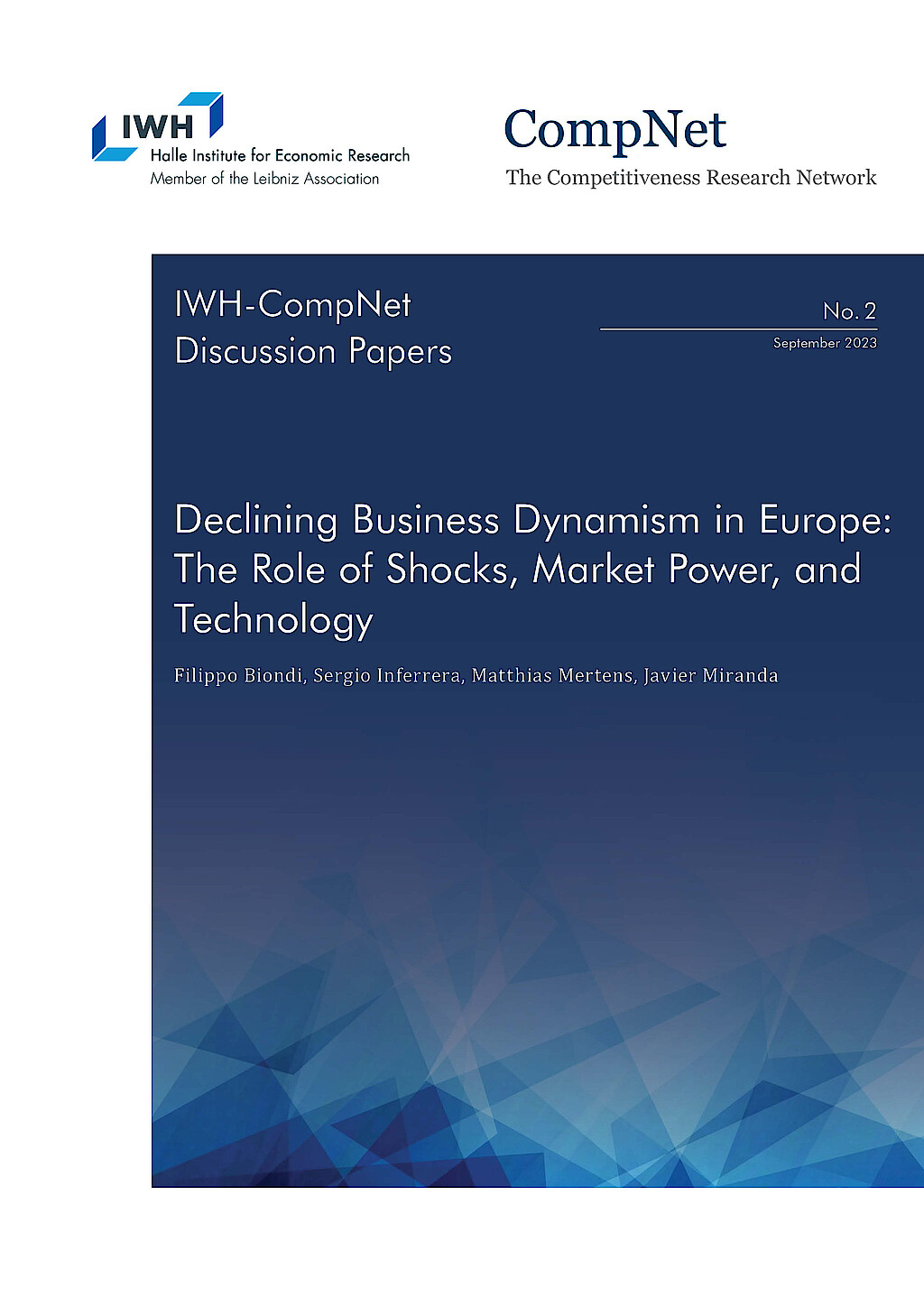
Declining Business Dynamism in Europe: The Role of Shocks, Market Power, and Technology
in: IWH-CompNet Discussion Papers, Nr. 2, 2023
Abstract
We study changes in business dynamism in Europe after 2000 using novel micro-aggregated data that we collected for 19 European countries. In all countries, we document a broad-based decline in job reallocation rates that concerns most economic sectors and size classes. This decline is mainly driven by dynamics within sectors, size, and age classes rather than by compositional changes. Large and mature firms experience the strongest decline in job reallocation rates. Simultaneously, the employment shares of young firms decline. Consistent with US evidence, firms’ employment has become less responsive to productivity shocks. However, the dispersion of firms’ productivity shocks has decreased too. To enhance our understanding of these patterns, we derive and apply a novel firm-level framework that relates changes in firms’ sales, market power, wages, and production technology to firms’ responsiveness and job reallocation.
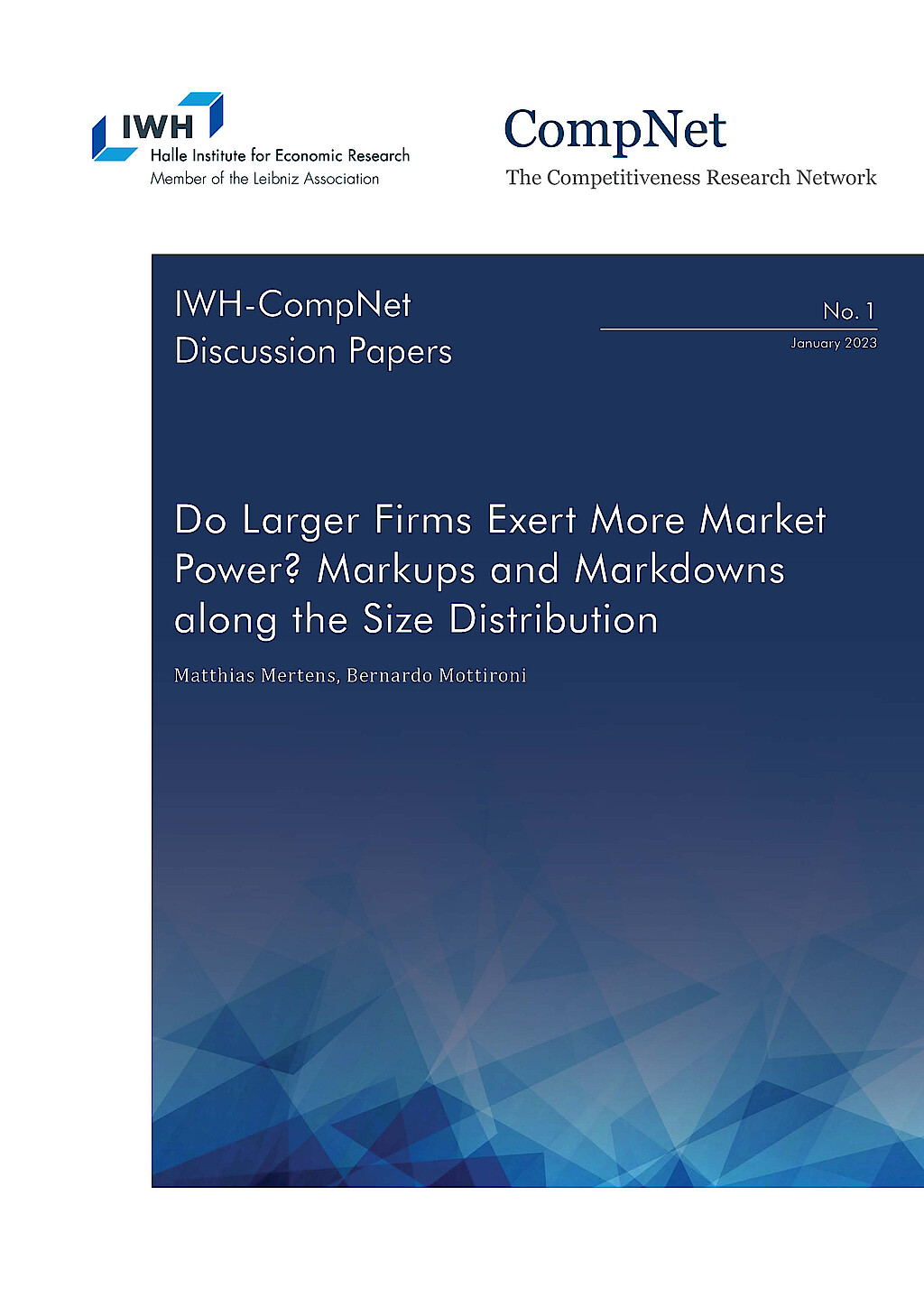
Do Larger Firms Exert More Market Power? Markups and Markdowns along the Size Distribution
in: IWH-CompNet Discussion Papers, Nr. 1, 2023
Abstract
Several models posit a positive cross-sectional correlation between markups and firm size, which characterizes misallocation, factor shares, and gains from trade. Accounting for labor market power in markup estimation, we find instead that larger firms have lower product markups but higher wage markdowns. The negative markup-size correlation turns positive when conditioning on markdowns, suggesting interactions between product and labor market power. Our findings are robust to common criticism (e.g., price bias, non-neutral technology) and hold across 19 European countries. We discuss possible mechanisms and resulting implications, highlighting the importance of studying input and output market power in a unified framework.
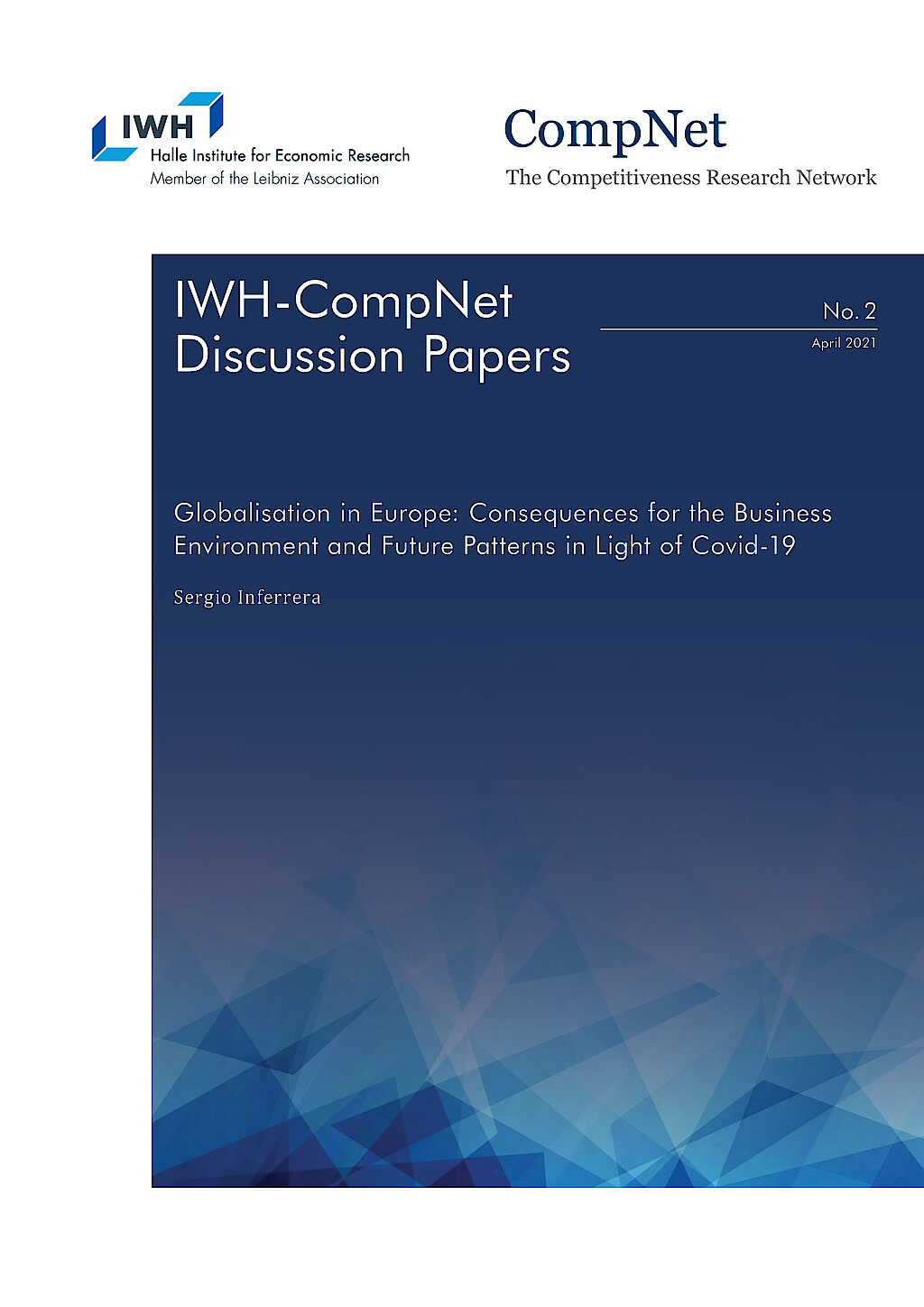
Globalisation in Europe: Consequences for the Business Environment and Future Patterns in Light of Covid-19
in: IWH-CompNet Discussion Papers, Nr. 2, 2021
Abstract
In this paper, I study the consequences of globalisation, as measured by the involvement of firms in GVC, on the business environment. In particular, I focus on concentration and productivity, firstly by estimating robust elasticities and then isolating the exogenous component of the variation in the participation in GVC. To this aim, I exploit the distance between industries in terms of upstreamness and downstreamness along the supply chain. The evidences suggest that involvement in international supply chains is positively related to concentration at the sector level and positively associated with aggregate productivity, an effect that is driven by the firms at the top of the productivity distribution. Finally, I relate these findings to the current pandemic, going beyond the lack of official statistics and estimating GVC participation for 2020 at the country-level through real time world-seaborne trade data, providing evidences on the re-absorption of the Covid shock in several European economies.

Benchmarking New Zealand's Frontier Firms
in: IWH-CompNet Discussion Papers, Nr. 1, 2021
Abstract
New Zealand has experienced poor productivity performance over the last two decades. Factors often cited as reasons behind this are the small size of the domestic market and distance to international partners and markets. While the distance reason is one that is fairly insurmountable, there are a number of other small advanced economies that also face similar domestic market constraints. This study compares the relative performance of New Zealand’s firms to those economies using novel cross-country microdata from CompNet. We present stylised facts for New Zealand relative to the economies of Belgium, Denmark, Finland, Netherlands and Sweden based on average productivity levels, as well as benchmarking laggard, median and frontier firms. This research also employs an analytical framework of technology diffusion to evaluate the extent of productivity convergence, and the impact of the productivity frontier on non-frontier firm performance. Additionally, both labour and capital resource allocation are compared between New Zealand and the other small advanced economies. Results show that New Zealand’s firms have comparatively low productivity levels and that its frontier firms are not benefiting from the diffusion of best technologies outside the nation. Furthermore, there is evidence of labour misallocation in New Zealand based on less labour-productive firms having disproportionally larger employment shares than their more productive counterparts. Counter-factual analysis illustrates that improving both technology diffusion from abroad toward New Zealand’s frontier firms, and labour allocation across firms within New Zealand will see sizable productivity gains in New Zealand.
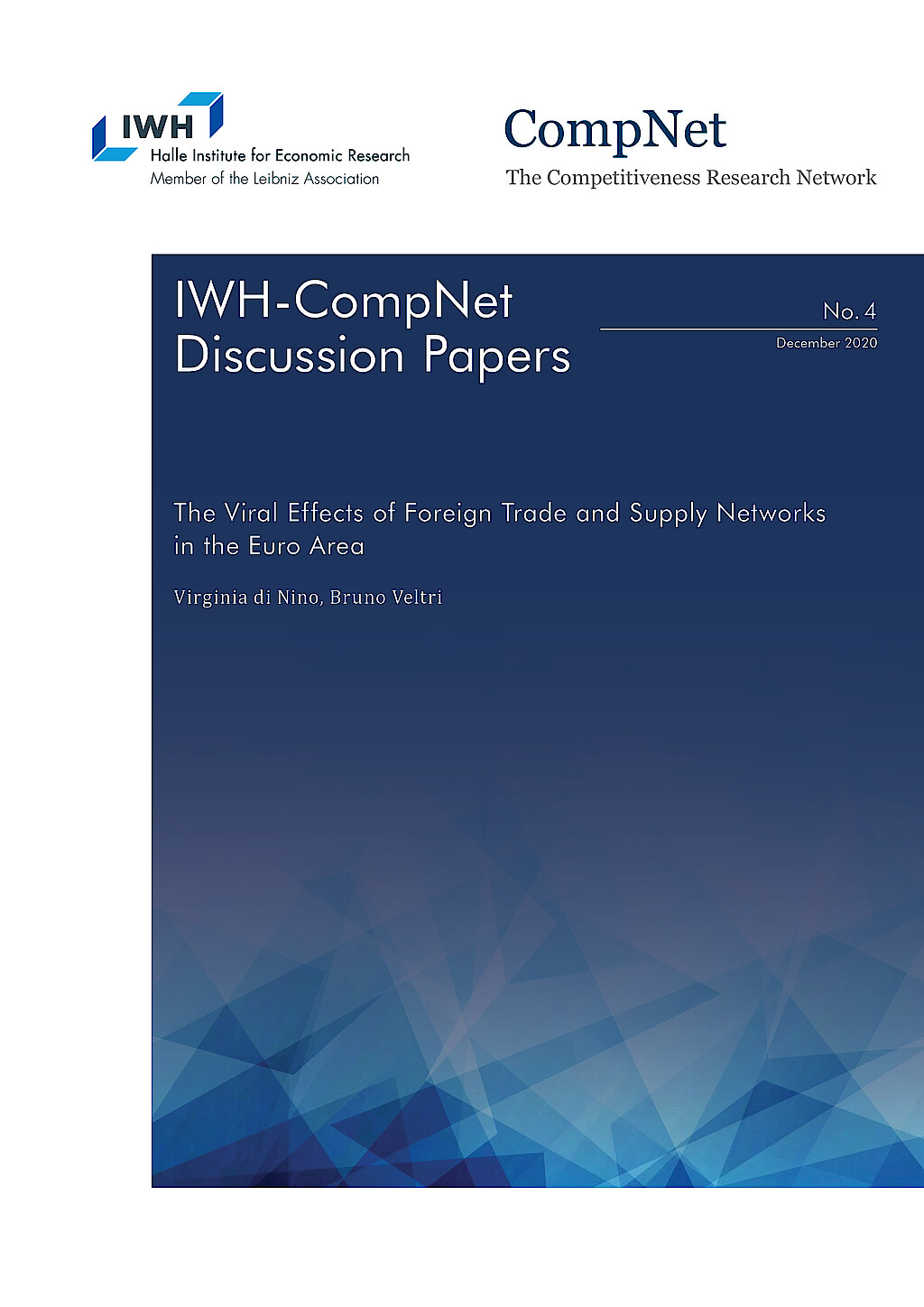
The Viral Effects of Foreign Trade and Supply Networks in the Euro Area
in: IWH-CompNet Discussion Papers, Nr. 4, 2020
Abstract
Containment measures of COVID-19 have generated a chain of supply and demand shocks around the globe with heterogeneous fallout across industries and countries. We quantify their transmission via foreign trade with a focus on the euro area where deep firms integration within regional supply chains and strong demand linkages act as a magnification mechanism. We estimate that spillover effects in the euro area from suppression measures in one of the five main euro area countries range between 15-28% the size of the original shock; negative foreign demand shocks depress euro area aggregate activity by about a fifth the size of the external shock and a fourth of the total effect is due to indirect propagation through euro area supply chain. Last, reopening to regional tourism softened the contraction of aggregate activity due to travel and tourism bans by about a third in the euro area. Our findings suggest that enhanced coordination of recovery plans would magnify their beneficial effects.
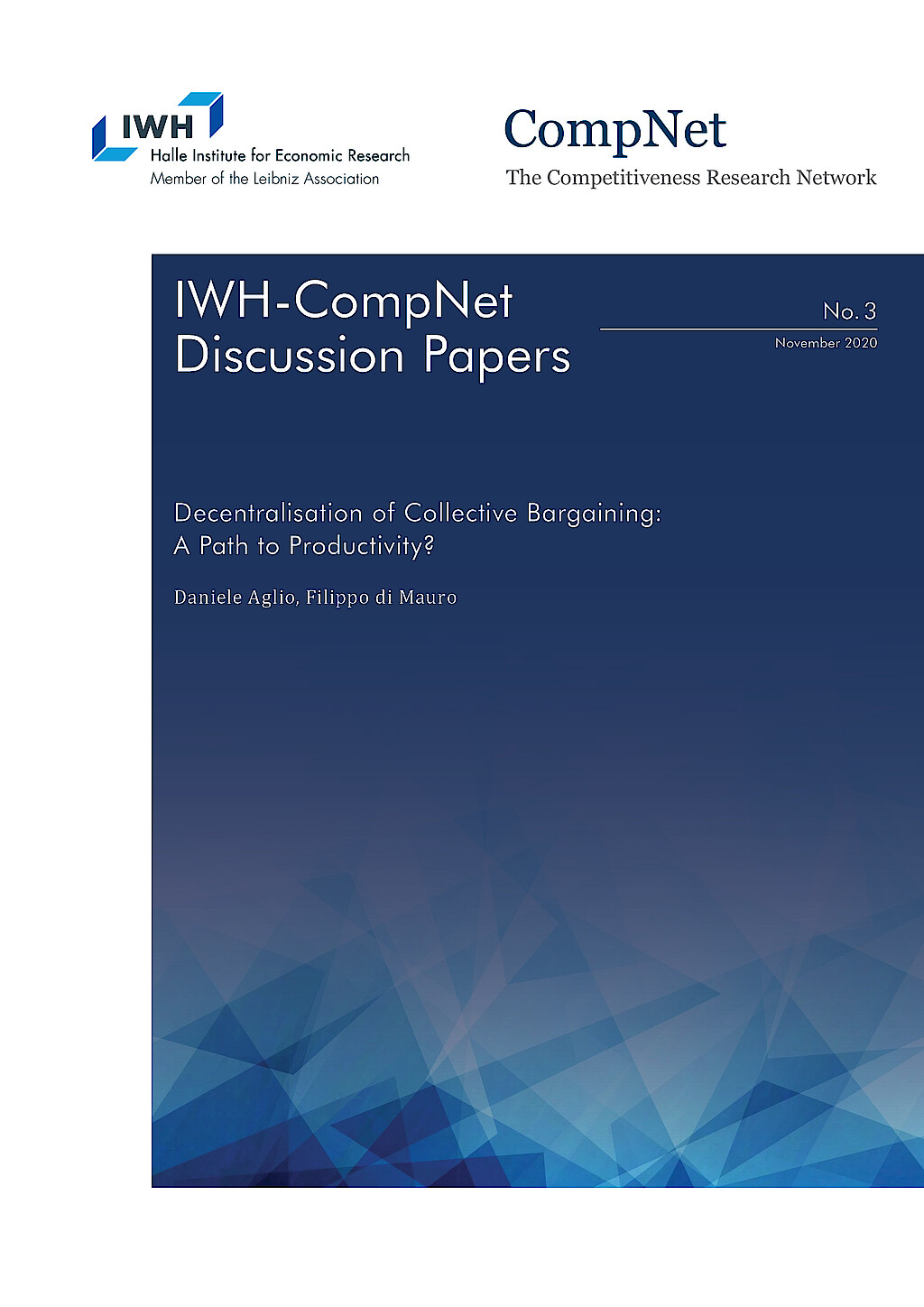
Decentralisation of Collective Bargaining: A Path to Productivity?
in: IWH-CompNet Discussion Papers, Nr. 3, 2020
Abstract
Productivity developments have been rather divergent across EU countries and particularly between Central Eastern Europe (CEE) and elsewhere in the continent (non-CEE). How is such phenomenon related to wage bargaining institutions? Starting from the Great Financial Crisis (GFC) shock, we analyse whether the specific set-up of wage bargaining prevailing in non-CEE may have helped their respective firms to sustain productivity in the aftermath of the crisis. To tackle the issue, we merge the CompNet dataset – of firm-level based productivity indicators – with the Wage Dynamics Network (WDN) survey on wage bargaining institutions. We show that there is a substantial difference in the institutional set-up between the two above groups of countries. First, in CEE countries the bulk of the wage bargaining (some 60%) takes place outside collective bargaining schemes. Second, when a collective bargaining system is adopted in CEE countries, it is prevalently in the form of firm-level bargaining (i. e. the strongest form of decentralisation), while in non-CEE countries is mostly subject to multi-level bargaining (i. e. an intermediate regime, only moderately decentralised). On productivity impacts, we show that firms’ TFP in the non-CEE region appears to have benefitted from the chosen form of decentralisation, while no such effects are detectable in CEE countries. On the channels of transmission, we show that decentralisation in non-CEE countries is also negatively correlated with dismissals and with unit labour costs, suggesting that such collective bargaining structure may have helped to better match workers with firms’ needs.
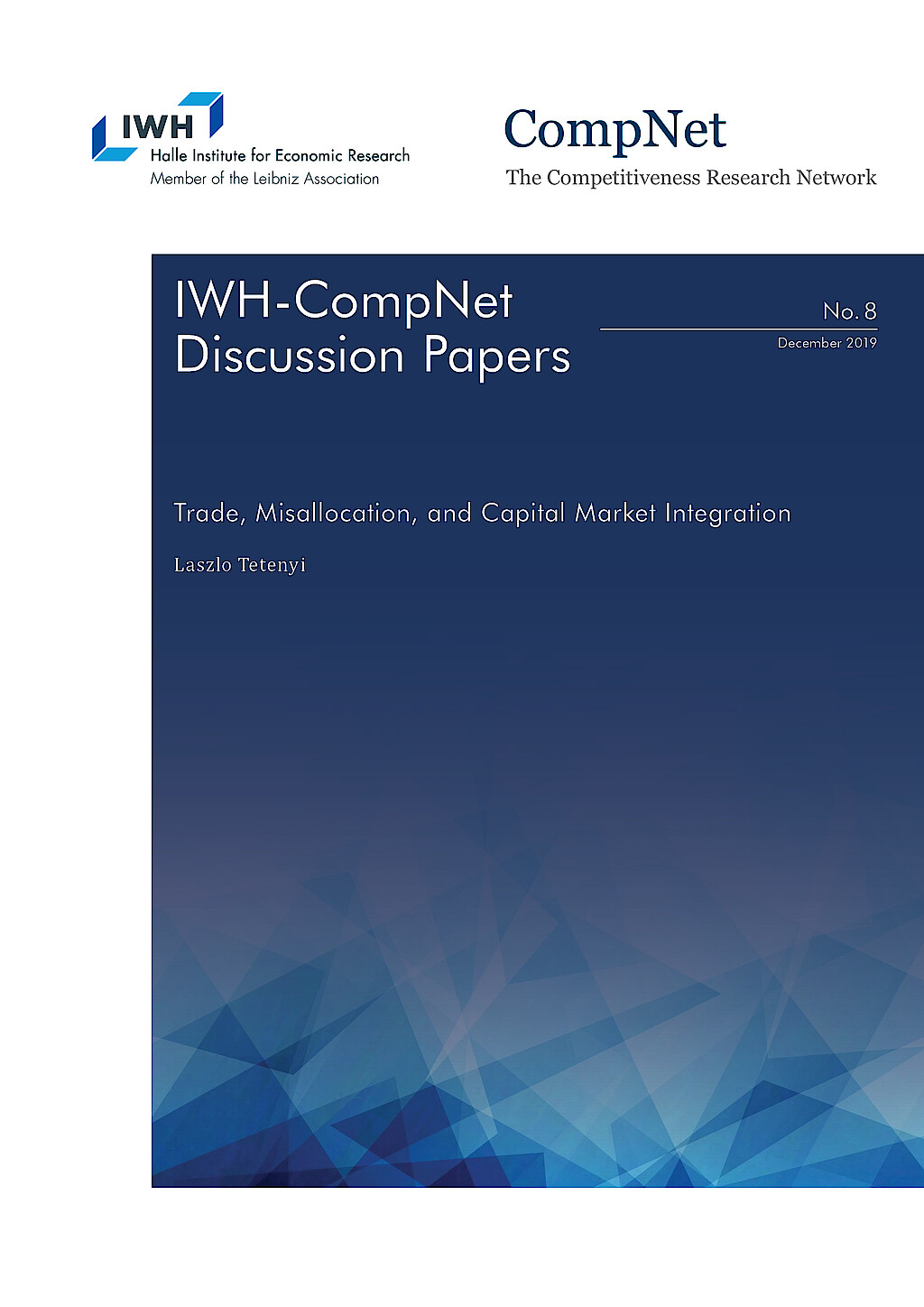
Trade, Misallocation, and Capital Market Integration
in: IWH-CompNet Discussion Papers, Nr. 8, 2019
Abstract
I study how cross-country capital market integration affects the gains from trade in a model with financial frictions and heterogeneous, forward-looking firms. The model predicts that misallocation among exporters increases as trade barriers fall, even as misallocation decreases in the aggregate. The reason is that financially constrained productive exporters increase their production only marginally, while unproductive exporters survive for longer and increase their size. Allowing capital inflows magnifies misallocation, because unproductive firms expand even more, leading to a decline in aggregate productivity. Nevertheless, under integrated capital markets, access to cheaper capital dominates the adverse effect on productivity, leading to higher output, consumption and welfare than under closed capital markets. Applied to the period of European integration between 1992 and 2008, I find that underdeveloped sectors experiencing higher export exposure had more misallocation of capital and a higher share of unproductive firms, thus the data is consistent with the model’s predictions. A key implication of the model is that TFP is a poor proxy for consumption growth after trade liberalisation.

Private Debt, Public Debt, and Capital Misallocation
in: IWH-CompNet Discussion Papers, Nr. 7, 2019
Abstract
Does finance facilitate efficient allocation of resources? Our aim in this paper is to find out whether increases in private and public indebtedness affect capital misallocation, which is measured as the dispersion in the return to capital across firms in different industries. For this, we use a novel dataset containing industrylevel data for 18 European countries and control for different macroeconomic indicators as potential determinants of capital misallocation. We exploit the within-country variation across industries in such indicators as external finance dependence, technological intensity, credit constraints and competitive structure, and find that private debt accumulation disproportionately increases capital misallocation in industries with higher financial dependence, higher R&D intensity, a larger share of credit-constrained firms and a lower level of competition. On the other hand, we fail to find any significant and robust effect of public debt on capital misallocation within our country-sector pairs. We believe the distortionary effects of private debt found in our analysis needs a deeper theoretical investigation.
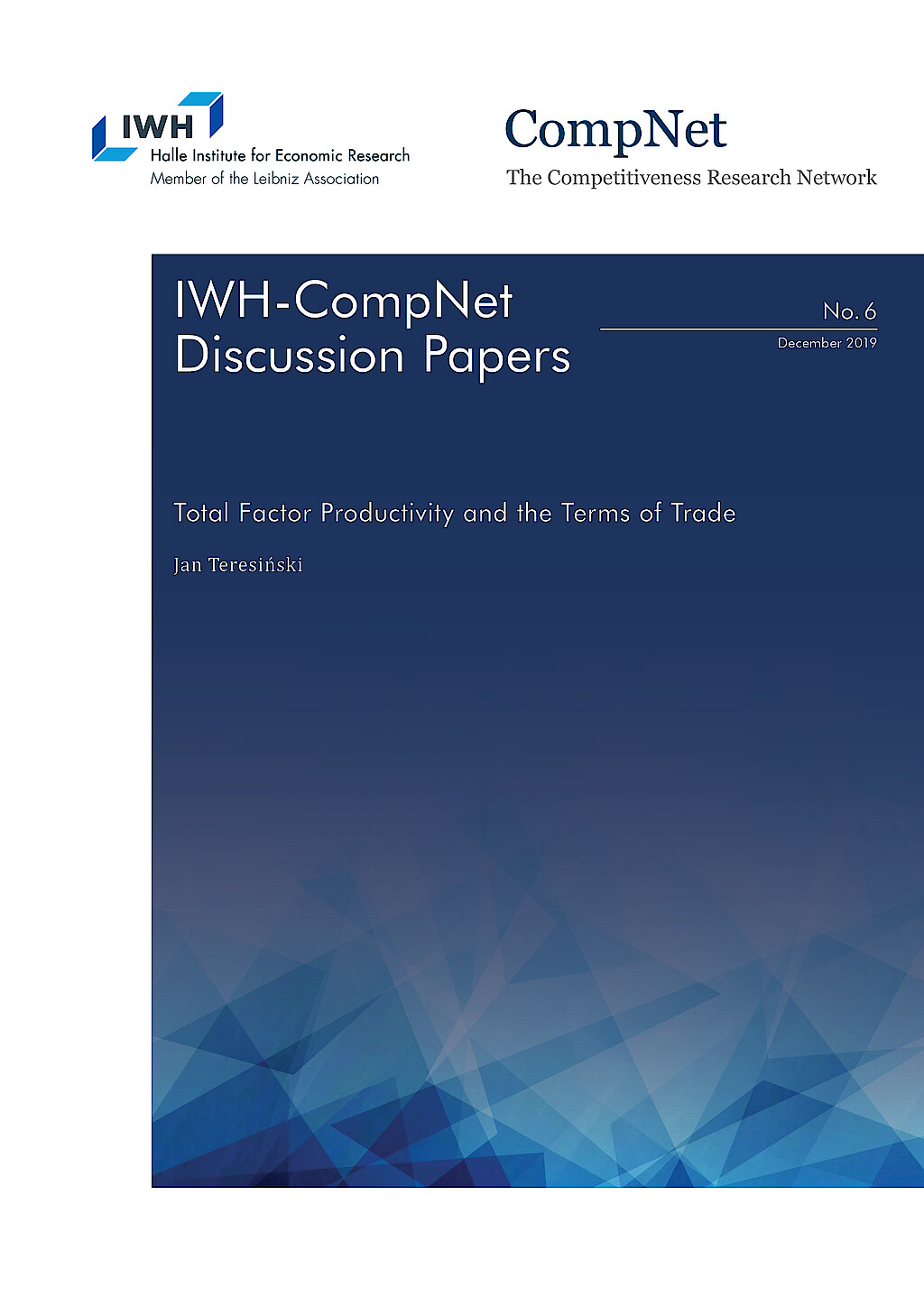
Total Factor Productivity and the Terms of Trade
in: IWH-CompNet Discussion Papers, Nr. 6, 2019
Abstract
In this paper we analyse how the terms of trade (TOT) – the ratio of export prices to import prices – affect total factor productivity (TFP). We provide empirical macroeconomic evidence for the European Union countries based on the times series SVAR analysis and microeconomic evidence based on industry level data from the Competitiveness Research Network (CompNet) database which shows that the terms of trade improvements are associated with a slowdown in the total factor productivity growth. Next, we build a theoretical model which combines open economy framework with the endogenous growth theory. In the model the terms of trade improvements increase demand for labour employed in exportable goods production at the expense of technology production (research and development – R&D) which leads to a shift of resources from knowledge development towards physical exportable goods. This reallocation has a negative impact on the TFP growth. Under a plausible calibration the model is able to replicate the observed empirical pattern.
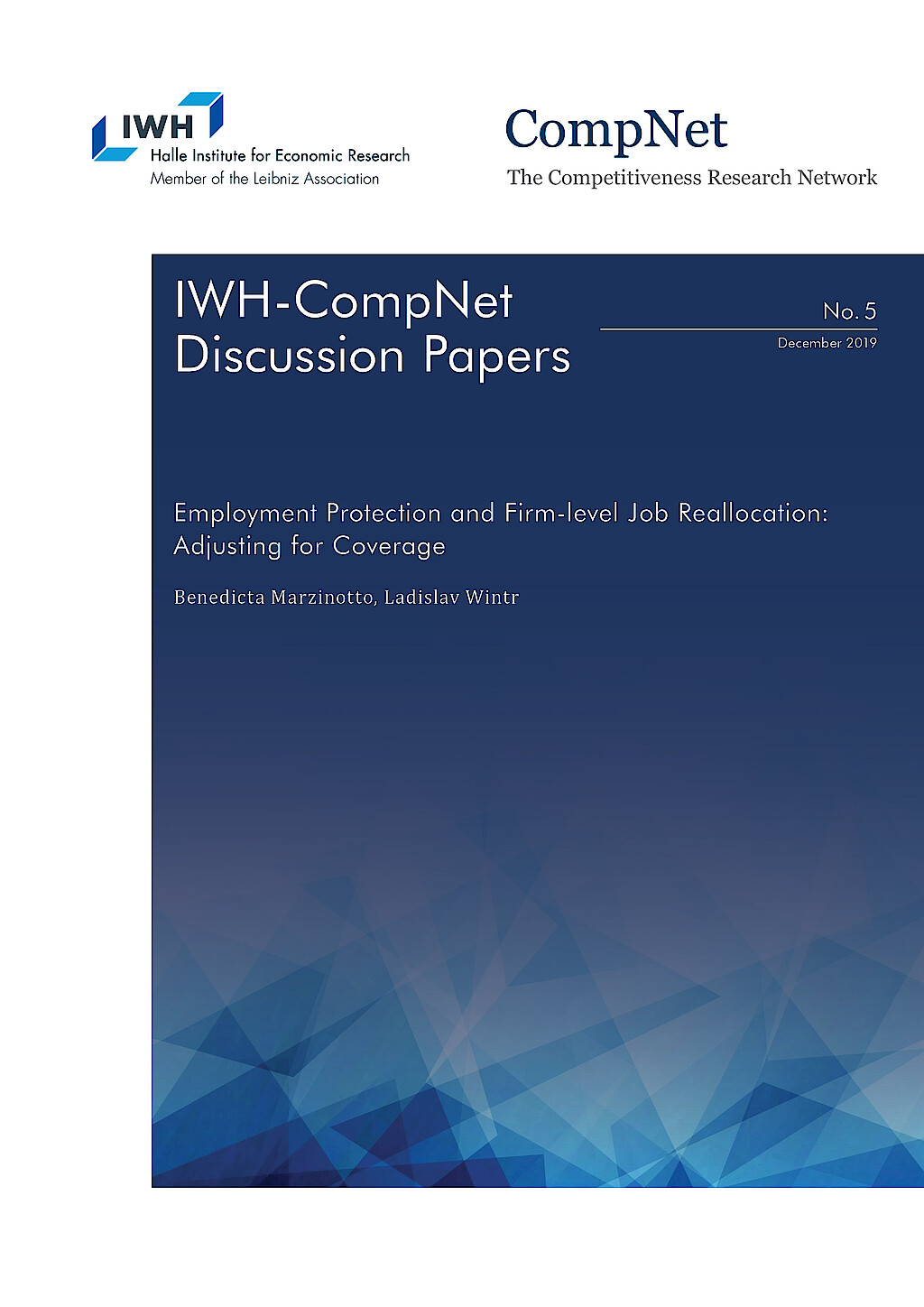
Employment Protection and Firm-level Job Reallocation: Adjusting for Coverage
in: IWH-CompNet Discussion Papers, Nr. 5, 2019
Abstract
This paper finds that employment protection legislation (EPL) had a significant impact on employment adjustment in Europe over 2001-2013, once we account for firm-size related exemptions to EPL. We construct a novel coverage-adjusted EPL indicator and find that EPL hinders employment growth at the firm level and increases the share of firms that remain in the same size class. This suggests that stricter EPL restrains job creation because firms fear the costs of shedding jobs during downturns. We do not find evidence that EPL has positive effects on employment by limiting job losses after adverse shocks. In addition to standard controls for the share of credit-constrained firms and the position in the business cycle, we also control for sizerelated corporate tax exemptions and find that these also significantly constrain job creation among incumbent firms.

Price-cost Margin and Bargaining Power in the European Union
in: IWH-CompNet Discussion Papers, Nr. 4, 2019
Abstract
Using firm-level data between 2004 and 2012 for eleven countries of the European Union (EU), we document the size of product and labour market imperfections within narrowly defined sectors including services which are virtually undocumented. Our findings suggest that perfect competition in both product and labour markets is widely rejected. Levels of the price-cost margin and union bargaining power tend to be higher in some service sectors depicting however substantial heterogeneity. Dispersion within sector and across countries tends to be higher in some services sectors assuming a less tradable nature which suggests that the Single Market integration is partial particularly relaxing the assumption of perfect competition in the labour market. We report also figures for the aggregate economy and show that Eastern countries tend to depict lower product and labour market imperfections compared to other countries in the EU. Also, we provide evidence in favour of a very limited adjustment of both product and labour market imperfections following the international and financial crisis.
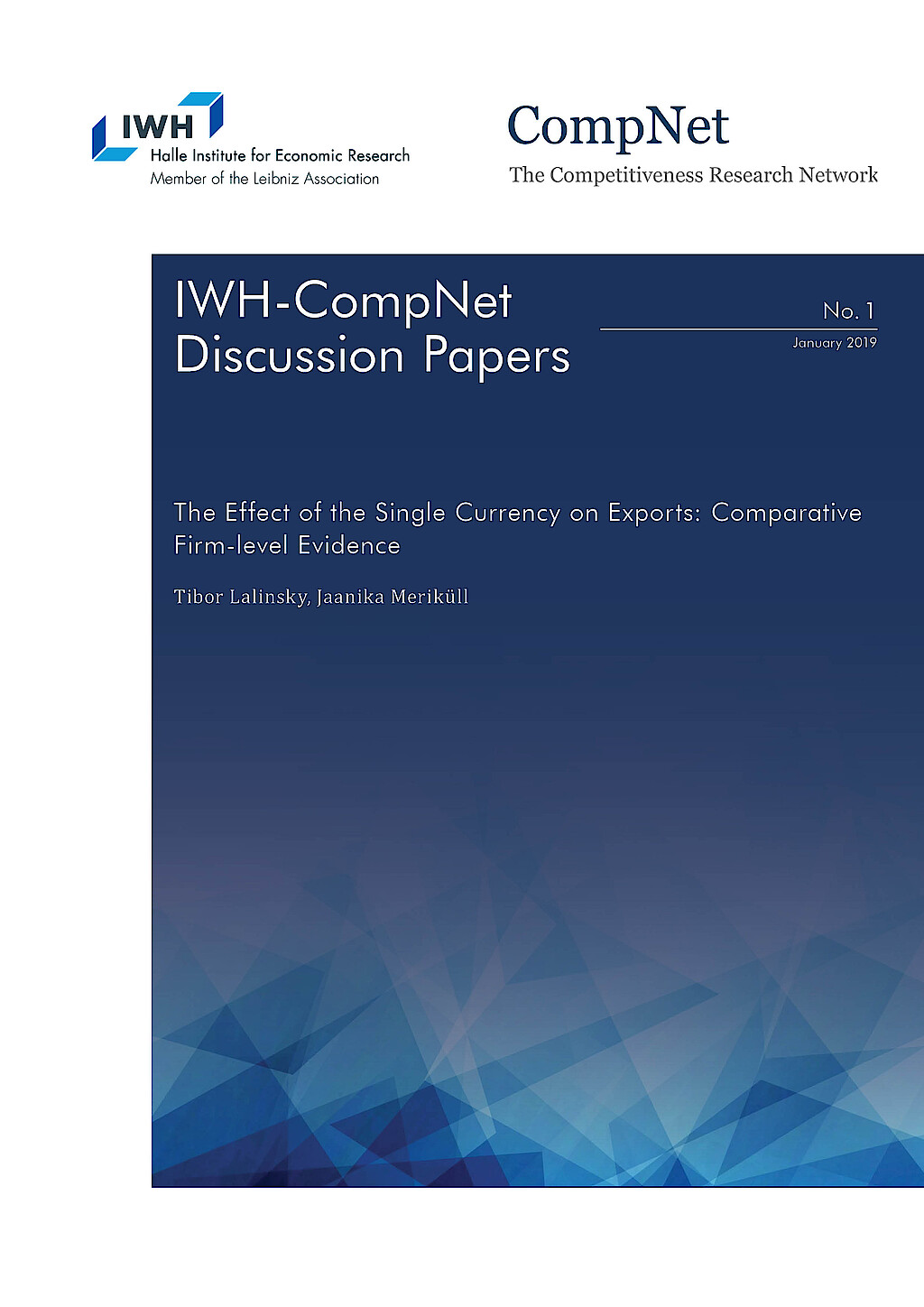
The Effect of the Single Currency on Exports: Comparative Firm-level Evidence
in: IWH-CompNet Discussion Papers, Nr. 1, 2019
Abstract
We investigate how adopting the euro affects exports using firm-level data from Slovakia and Estonia. In contrast to previous studies, we focus on countries that adopted the euro individually and had different exchange rate regimes prior to doing so. Following the New Trade Theory we consider three types of adjustment: firm selection, changes in product varieties and changes in the average value of the exports that compose the exports of individual firms. The euro effect is identified by a difference in differences analysis comparing exports by firms to the euro area countries with exports to the EU countries that are not members of the euro area. The results highlight the importance of the transaction costs channel related to exchange rate volatility. We find the euro has a strong pro-trade effect in Slovakia, which switched to the euro from a floating exchange rate, while it has almost no effect in Estonia, which had a fixed exchange rate to the euro prior to the euro changeover. Our findings indicate that the euro effect manifested itself mainly through the intensive margin and that the gains from trade were heterogeneous across firm characteristics.
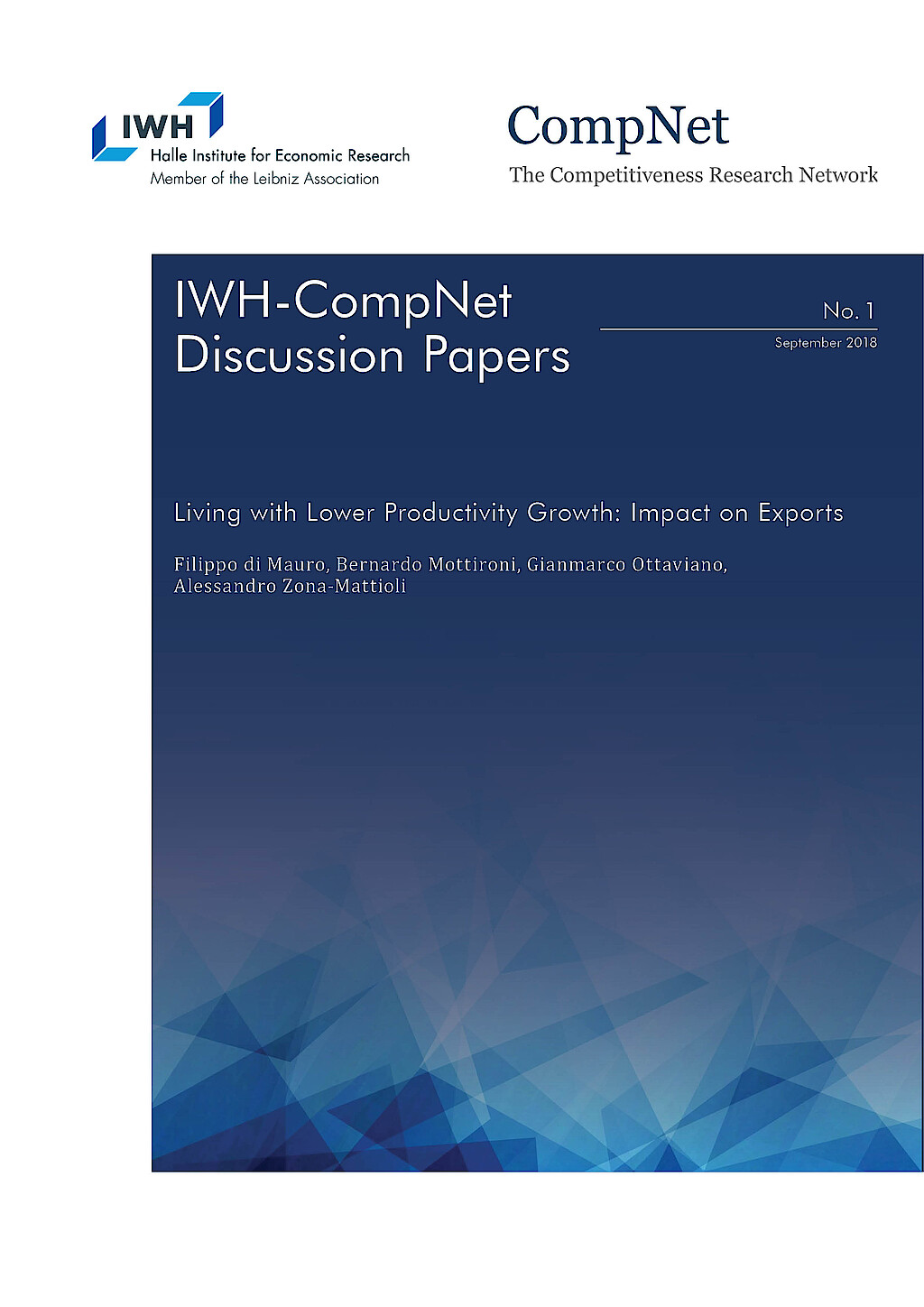
Living with Lower Productivity Growth: Impact on Exports
in: IWH-CompNet Discussion Papers, Nr. 1, 2018
Abstract
This paper investigates the impact of sustained lower productivity growth on exports, by looking at the role of the productivity distribution and allocative efficiency as drivers of export performance. It follows and goes beyond the work of Barba Navaretti et al. (2017), analysing the effects of productivity on exports depending on the dynamics of allocative efficiency. Low productivity growth is a well-documented stylised fact in Western countries – and possibly a reality likely to persist for some time. What could be the impact of persistent sluggish growth of productivity on exports? To shed light on this question, this paper examines the relationship between the productivity distribution of firms and sectoral export performance. The structure of firms within countries or even sectors matters tremendously for the nexus between productivity and exports at the macroeconomic level, as the theoretical and empirical literature documents. For instance, whether too few firms at the top (lack of innovation) or too many firms at the bottom (weak market selection) drives slow average productivity at the macro level has very different implications and therefore demands different policy responses.
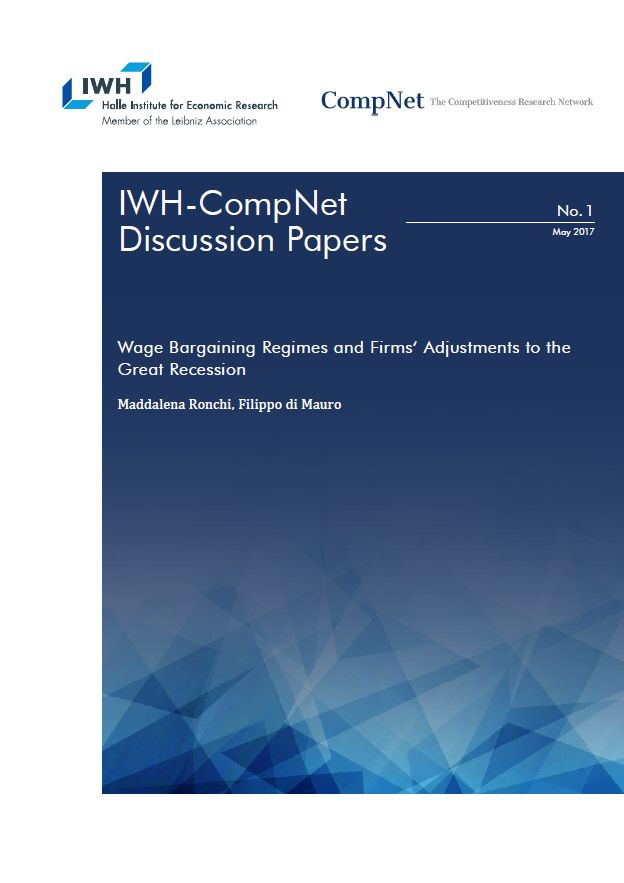
Wage Bargaining Regimes and Firms‘ Adjustments to the Great Recession
in: IWH-CompNet Discussion Papers, Nr. 1, 2017
Abstract
The paper aims at investigating to what extent wage negotiation set-ups have shaped up firms’ response to the Great Recession, taking a firm-level cross-country perspective. We contribute to the literature by building a new micro-distributed database which merges data related to wage bargaining institutions (Wage Dynamic Network, WDN) with data on firm productivity and other relevant firm characteristics (CompNet). We use the database to study how firms reacted to the Great Recession in terms of variation in profits, wages, and employment. The paper shows that, in line with the theoretical predictions, centralized bargaining systems – as opposed to decentralized/firm level based ones – were accompanied by stronger downward wage rigidity, as well as cuts in employment and profits.
Your contact

Wissenschaftlicher Mitarbeiter
Für Rückfragen stehe ich Ihnen gerne zur Verfügung.
+49 345 7753-709 Anfrage per E-Mail


